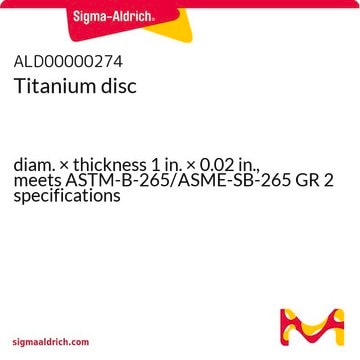268526
Titanium
sponge, 1-20 mm, 99.5% trace metals basis
Sign Into View Organizational & Contract Pricing
All Photos(3)
About This Item
Empirical Formula (Hill Notation):
Ti
CAS Number:
Molecular Weight:
47.87
EC Number:
MDL number:
UNSPSC Code:
12141746
PubChem Substance ID:
NACRES:
NA.23
Recommended Products
Assay
99.5% trace metals basis
form
sponge
autoignition temp.
860 °F
resistivity
42.0 μΩ-cm, 20°C
particle size
1-20 mm
bp
3287 °C (lit.)
mp
1660 °C (lit.)
density
4.5 g/mL at 25 °C (lit.)
SMILES string
[Ti]
InChI
1S/Ti
InChI key
RTAQQCXQSZGOHL-UHFFFAOYSA-N
Related Categories
Signal Word
Danger
Hazard Statements
Precautionary Statements
Hazard Classifications
Flam. Sol. 1
Storage Class Code
4.2 - Pyrophoric and self-heating hazardous materials
WGK
nwg
Flash Point(F)
Not applicable
Flash Point(C)
Not applicable
Personal Protective Equipment
dust mask type N95 (US), Eyeshields, Gloves
Choose from one of the most recent versions:
Already Own This Product?
Find documentation for the products that you have recently purchased in the Document Library.
Customers Also Viewed
Jinho Shin et al.
Journal of nanoscience and nanotechnology, 13(8), 5807-5810 (2013-07-26)
In this study, hydroxyapatite (HA) was coated on anodized titanium (Ti) surfaces through radio frequency magnetron sputtering in order to improve biological response of the titanium surface. All the samples were blasted with resorbable blasting media (RBM). RBM-blasted Ti surface
D M Rivera-Chacon et al.
Journal of biomedical nanotechnology, 9(6), 1092-1097 (2013-07-19)
Improvements in osteoconduction of implant biomaterials require focusing on the bone-implant interface, which is a complex multifactorial system. Surface topography of implants plays a crucial role at this interface. Nanostructured surfaces have been shown to promote serum protein adsorption and
Kwi-Dug Yun et al.
Journal of nanoscience and nanotechnology, 13(6), 3864-3867 (2013-07-19)
This study examined the bone response to titanium dioxide nanotube modified implants. A total of 24 implants were placed in the femur of 4 beagles. Before placement, screw-shaped implants were classified into 3 groups; machined surface (group M), titanium dioxide
Woo-Byoung Kim et al.
Journal of nanoscience and nanotechnology, 13(7), 4622-4626 (2013-08-02)
To investigate the microstructural effects of the synthesized TiO2 nanopowders such as particle size, specific surface area, pore size and pore distributions for the application of an anode material of dye-sensitized solar cells (DSSC), size-controlled and well-dispersed TiO2 nanopowders were
Lu-Ning Wang et al.
Journal of nanoscience and nanotechnology, 13(8), 5316-5326 (2013-07-26)
Electrochemically anodized TiO2 nanotubular arrays can provide large surface areas for biological species attachment. In order to further enhance the biocompatibility of Ti medical implants, we deposited a pre-synthesized hydroxyapatite inside and on the nanotubular arrays, and examined the biocompatibility
Our team of scientists has experience in all areas of research including Life Science, Material Science, Chemical Synthesis, Chromatography, Analytical and many others.
Contact Technical Service



